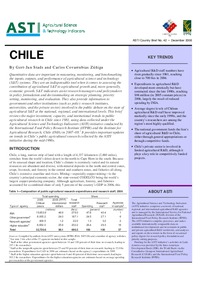Authors:
Stads , Gert-Jan; Zúñiga, Carlos Covarrubias
Year:
2008
Publisher
International Food Policy Research Institute (IFPRI); and Institute for Agricultural Research, Chile (INIA)
Back to:
Despite a decrease in the total number of researchers at INIA in recent years, overall agricultural research capacity in Chile rose gradually during 1981–2006. In 2006, the country as a whole employed close to 700 fte scientists involved in agricultural R&D. The country’s agricultural R&D spending, however, developed more erratically. The completion of a large IDBfinanced project, in addition to cost-cutting measures introduced by INIA, have led to a gradual fall in the country’s expenditures since the late 1990s. In 2006, Chile invested just under $100 million (in 2005 constant prices) on agricultural R&D, or 1.22 percent of its AgGDP. Despite the fall in total agricultural R&D spending in recent years, Chile compares favorably to many of its Latin American counterparts, in terms of public-sector
intensity of investment in agricultural R&D.
Although internally generated resources play a very important role in financing Chilean agricultural R&D, the lion’s share of the country’s R&D investments are financed by the national government, either through general appropriations or through a number of competitive funds, which typically require counterpart funding from the private/productive sector. A large number of competitive funds in support of agricultural R&D exist side by side, on occasion with overlapping or duplicating focus, sometimes leading to research programs that add up to an incoherent project portfolio or programs that do not always serve the priorities of the country as a whole. Nonetheless, these competitive funds have enhanced cooperation among R&D agencies, as well as between agencies and the private sector, and are said to have made the day-to-day operation of many R&D agencies much more efficient.
Overall, Chile’s agricultural R&D system is adequately staffed and funded and has played a critical role in the emergence of the country’s fruit, wine, and salmon industries in recent decades. However, the complex institutional structure of the various competitive funds and agencies involved in S&T policy formulation sometimes leads to confusing procedures and an unnecessary (and costly) overlap and duplication of activities. The establishment of an effective single national institute responsible for S&T policy could solve many of these problems. In addition, the country needs a clear long-term strategy that involves both the public and the private sector if it is to maintain and enhance its competitive position in a global market.

